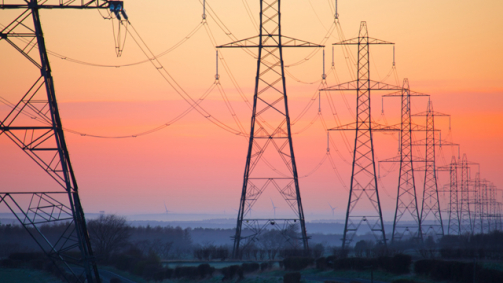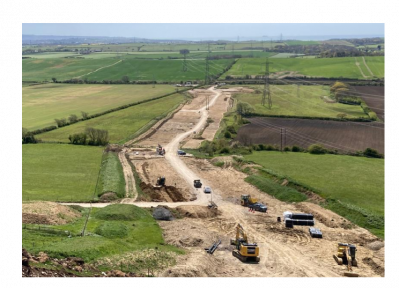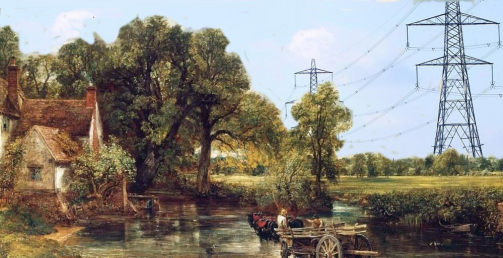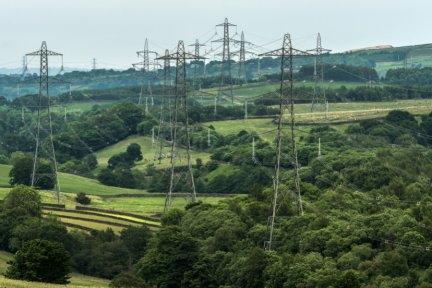For us at Bressingham Gardens, with a 17 acre world renowned garden, the popular steam museum and the recently established Hall and Barn wedding venue, the pylons would be nothing short of a disaster.

FOUR IMPORTANT ACTIONS NEEDED NOW:

ARGUMENTS AGAINST PYLONS:
-
People living, working and visiting any area nearby would no longer view the beautiful Norfolk, Suffolk and Essex country landscape, but instead a scar of pylons and cables, set at 50m in height – an electrical infrastructure that most people consider a bad decision from the 1960’s. 50m is twice the height of many mature trees. This region is known for it’s ‘big skies’, and it would not be possible to hide the pylons marching across the flat and open agricultural landscape. This is a breach of the Holford Rules.
-
Pylons and cables are simply the cheapest option for the purpose, and the most inconsiderate; “The advantages of overhead lines over underground cables are that, so far, the costs of building overhead lines have been significantly less than installing underground cables… The main drawbacks of overhead lines are their use of land, their visual and different environmental impacts” (Energy Guidance and EU Nature Legislation, p30). It should be understood, National Grid is in fact a publicly listed utility company, making massive annual profits (see news articles below), with operations in electricity and gas, in both the UK and the US.
-
Pylons can no longer be considered an “engineering innovation” (READ FULL ARTICLE ), when inter-connectors (high-voltage under-sea cables) are regularly used to transmit electricity for hundreds of miles between countries, and 32km of new cabling is presently being tunnelled under the metropolis of London.
-
Nobody would accept having these pylons and cables in their view, let alone their garden or land. This proposal, to install pylons and cables, by National Grid does not respect that the quality of life of the people in these areas will be diminished for several generations.
-
The proposed route passes through or by;
-
Wortham Ling – a SSSI, and a popular nature area visited by the public.
-
Bressingham Steam Museum – South Norfolk’s most popular visitor attraction (60,000/year), where steam trains take visitors on rides through the woods and meadows. The pylons and cables would pass over 4 railway lines i.e. the visitors would pass under the cables on 4 different occasions (this is a health and safety issue – see below), with the pylons and cables dominating the view at all times. This would obviously degrade the ambience and visitor experience.
-
Bressingham Gardens – world renowned heritage gardens, open to the public.
-
Bressingham Hall and High Barn – wedding and events venue in Listed buildings.
All these local businesses utilise the unspoiled woods and meadows in the valley and would be detrimentally effected by the installation of these pylons, because of the degraded ambience and visitor experience, inevitably resulting in lost business and lost income, and eventually lost jobs. How are businesses and people to plan for the future when their future is in question?
-
-
The land to the west of Wortham Ling is fenland, of high ecological value, and managed for wild birds, winter waders and wildfowl. Pylons and cables would ruin this natural landscape, and would be detrimental to birdlife, and even cause collision risks and a barrier effects (see attached ‘Energy Guidance and EU Nature Legislation’ p27). The Waveney is classed a Statutory River, and the valley meadows are designated Flood Zone 3 – both of which NG are constrained to ‘seek to minimise’ routeing pylons on or over.
-
Many of the woodlands here are ‘high priority woodlands’ and some are designated County Wildlife Sites.
-
The valley land between Knettishall Heath in the west, and Diss town in the east are part of a farm cluster around the headwaters of the Waveney and Little Ouse rivers, in partnership with neighbouring landowners and environmental charities, including Suffolk Wildlife Trust, as part of the Landscape Recovery scheme, and Environmental Land Management scheme, developed by DEFRA.
-
Some quotes from the ‘Energy Guidance and EU Nature Legislation’; “When assessing the potential impacts on nature and wildlife it is important to consider not just the main infrastructure itself, but also all associated installations and facilities such as temporary access roads, contractors facilities and equipment storage, construction compounds, concrete foundations, temporary cabling, spoils and areas for soil surplus etc. The impacts may be temporary or permanent, on-site or off-site, cumulative and may come into play at different times during the project cycle (e.g. during construction, renovation, maintenance and/or decommissioning phases). All these factors must be taken into consideration.”. For more disturbing quotes, see p25+.
- It is ironic – that sustainable ‘GREEN’ electricity production (National Grids acronym), generated off-shore in-part to preserve the landscape, to supply the growing demand for electricity for eco-friendly developments such as non-polluting electric transport, causes a 180km swathe of the countryside to be completely compromised by the erection of technologically-outdated pylons, with no respect for the local inhabitants established standard of life, or visitors appreciation and enjoyment of nature, or natures needs for space and freedom from human interventions. Millions of trees and the biodiversity they support would be destroyed if National Grid are allowed to route cables via the land. There is nothing ‘green’ about this form of electricity transmission.
- The UK Governments website plays down the potential effects of electric and magnetic fields caused by pylons, however it states; “Some people notice the strong electric fields found outdoors beneath large power lines, through hair standing on end. Under some circumstances, people can experience microshocks, like a static shock, coming from contact with objects in strong electric fields. These effects only occur at field levels much higher than those encountered in homes.”. READ FULL ARTICLE HERE
-
National Grids director of new infrastructure, Zac Richardson, has said that the firm does not believe it is “technically feasible or economic” for the line to go offshore (BBC). And yet, National Grid have recently powered up the worlds longest subsea cable – 700km in length – between the UK and Norway (North Sea Link) National Grid are also planning a 3800km subsea cable from Morocco to the UK (Morocco-UK Power Project) . If these projects are feasible, can National Grid genuinely expect the public to believe a UK offshore ring main is not? NSL cost £1.6bn. NG made a profit of £3.4bn in 2021 alone. So NG have the finances to go offshore, but are proposing only the most “economic” solution of 1300 pylons across the countryside.
- National Grid are proposing replacing “a 3.3km section of double overhead lines and pylons with an underground cable tunnel and associated infrastructure, on the western edge of the Snowdonia National Park … to reduce the impact … on visual amenity” (Ofgem). And in Dorset National Grid “is replacing 22 pylons and 8.8km of wires with underground cables … one of the first projects in the world to remove existing high-voltage electricity transmission infrastructure solely to enhance the landscape.” (The Going Underground project) National Grid obviously recognise the visual impact of pylons, but despite available new technology, would hypocritically still seek to force pylons on East Anglia.
- Planning barrister, Charles Banner, QC, appointed by PylonsEastAnglia has concluded that National Grid consultation has contravened the Gunning Principles; “NG has already resolved to proceed with the Project and to discount alternative options, including in particular alternative which involve no, or considerably fewer, pylons (including underground and/or undersea routes, and/or upgrading existing infrastructure).”; “NG has so resolved without having first evaluated the relative environmental impacts of the preferred route corridor against the alternatives which involve no or considerably fewer pylons.”; “the lay public consultees have not been provided with anything approaching a sufficient level of information to enable them to make an intelligent comparison of the environmental impacts of the preferred option compared to alternatives which involve no or considerably fewer pylons.”
- The IPC (Infrastructure Planning Commission) require National Grid to assess all likely significant effects of infrastructure proposals; Schedule 9 to the Electricity Act 1989 places a duty on National Grid to “have regard to the desirability of preserving natural beauty, of conserving flora, fauna and geological or physiographical features of special interest and of protecting sites, buildings and objects of architectural, historic or archaeological interest; and … do what [they] reasonably can to mitigate any effect which the proposals would have on the natural beauty of the countryside or on any such flora, fauna, features, sites, buildings or objects.”; “Climate change is likely to increase risks to the resilience of some infrastructure from flooding (particularly for substations), effects of wind and storms on overhead lines, higher average temperatures leading to increased transmission losses, and earth movement or subsidence caused by flooding or drought (for underground cables)”; “Large birds such as swans and geese may collide with overhead lines, particularly in poor visibility. Large birds may be electrocuted when landing or taking off. Even perching birds can be killed as soon as their wings touch energised parts.”; “All high voltage transmission lines have the potential to generate noise generally categorised as ‘crackle’ or ‘hum’. All overhead power lines produce EMFs, and these tend to be highest directly under a line. Although putting cables underground eliminates the electric field, they still produce magnetic fields, which are highest directly above the cable. EMFs can have both direct and indirect effects on human health. The direct effects occur in terms of impacts on the central nervous system resulting in its normal functioning being affected. Indirect effects occur through electric charges building up on the surface of the body producing a microshock on contact with a grounded object, or vice versa, which, depending on the field strength and other exposure factors, can range from barely perceptible to being an annoyance or even painful.”
- The East Coast Grid Spatial Study, prepared for the Crown Estate (manager of the seabed), states “Numerous studies over the last decade have identified significant potential capital expenditure savings of a more coordinated approach as opposed to continuing with radial links; the most recent of these was National Grid … estimated in total £9bn in savings by 2050. There are also clear societal and environmental advantages, such as reduced onshore infrastructure requirements meaning lesser impacts on local coastal communities and a smaller overall footprint for the infrastructure.”
- The Government’s ambition is for 40 GW of offshore wind by 2030 as well as net zero by 2050. National Grid states “there is significant benefit in moving quickly to an integrated network … also significant environmental and social benefits, as the number of new electricity infrastructure assets, including cables and onshore landing points, could be reduced by around 50 per cent”. Considering the time pressure to meet decarbonisation targets, persevering with this proposal of pylons will result in a stand-off between National Grid and the public which will waste more time and resources that should without question be focused on a more equitable solution for all. The only solution is Offshore.
FURTHER READING
EDP “South Norfolk Council set to object to pylon plans” READ HERE
BBC “Norfolk steam train museum’s fear over new power line” READ HERE
QC finds legal deficiencies with National Grid’s pylon consultation SEE CONCLUSIONS P11
EDP “Pylons could be ‘disastrous’ for steam museum” READ HERE
Suffolk News “National Grid accused of ‘green-washing’ over Suffolk consultation for new overhead pylons” READ HERE
The Guardian “National Grid CEO’s £1.1m pay rise criticised as UK energy bills soar” READ HERE
EADT “Six MPs write to government over Suffolk and Essex pylon plans”; READ HERE
Sky News “National Grid’s profits rise to £3.4bn amid soaring energy bills“; READ HERE
The Off Shore Electricity Grid Task Force (OffSET) “exists to promote… a coordinated offshore electricity grid… while standing up for the countryside of East Anglia so that the welcome transition to net zero electricity generation does not do unnecessary damage to our communities or the environment.” READ MORE HERE
Essex Suffolk Norfolk Pylons action group is opposed to the 180km of pylons… (and instead) seek a strategic offshore grid instead and support the work of the ‘OffSET’ taskforce. FIND THEM HERE
and their Facebook group FIND THEM HERE
and further actions HERE
BBC “Campaigners oppose 112-mile East Anglia power line” READ HERE
EADT “Plans for 180km of pylons across East Anglia could be challenged in court” READ HERE
EDP “Metal monstrosities’ – Opposition to new East Anglia power line grows” READ HERE
Gov.UK “Electric and magnetic fields: health effects of exposure” READ HERE
CPRE Norfolk believes that underground cabling should be used for any new National Grid transmission lines. READ HERE
Guidance on Energy Transmission Infrastructure and nature legislation – see pages 25-35 pdf attached HERE

This is clearly not our field of expertise, we and our neighbours have unfortunately found ourselves in the position of having to scramble to try to defend the Norfolk/Suffolk/Essex countryside. We will endeavour to develop the information on this page as we learn more.


